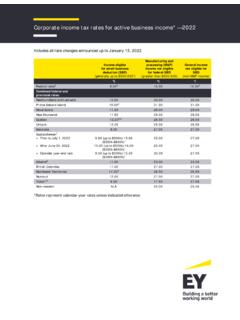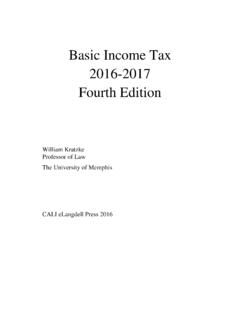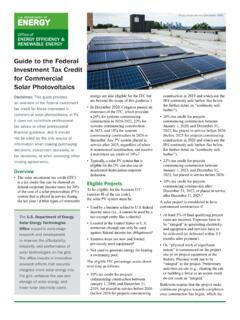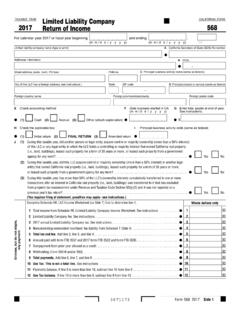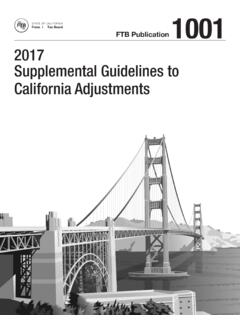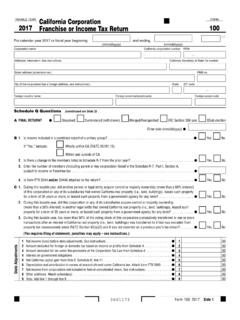Transcription of ARTICLES OF THE MODEL - OECD
1 ARTICLES OF THEMODEL CONVENTIONWITH RESPECT TO TAXES ON income AND ON CAPITAL[as they read on 21 November 2017]SUMMARY OF THE CONVENTIONT itle and PreambleChapter ISCOPE OF THE CONVENTIONA rticle 1 Persons coveredArticle 2 Taxes coveredChapter IIDEFINITIONSA rticle 3 General definitionsArticle 4 ResidentArticle 5 Permanent establishmentChapter IIITAXATION OF INCOMEA rticle 6 income from immovable propertyArticle 7 Business profitsArticle 8 International shipping and air transportArticle 9 Associated enterprisesArticle 10 DividendsArticle 11 InterestArticle 12 RoyaltiesArticle 13 Capital gainsArticle 14 [Deleted] article 15 income from employmentArticle 16 Directors feesArticle 17 Entertainers and sportspersonsArticle 18 PensionsArticle 19 Government serviceArticle 20 StudentsArticle 21 Other incomeChapter IVTAXATION OF CAPITALA rticle 22 CapitalARTICLES OF THE MODEL CONVENTION [as they read on 21 November 2017]2 OECD 2017 Chapter VMETHODS FOR ELIMINATION OF DOUBLE TAXATIONA rticle 23 A Exemption methodArticle 23 B Credit methodChapter VISPECIAL PROVISIONSA rticle 24 Non-discriminationArticle 25 Mutual agreement procedureArticle 26 Exchange of informationArticle 27 Assistance in the collection of taxesArticle 28 Members of diplomatic missions and consular postsArticle 29 Entitlement to benefitsArticle 30 Territorial extensionChapter VIIFINAL PROVISIONSA rticle 31 Entry into forceArticle 32 TerminationARTICLES OF THE MODEL CONVENTION [as they read on 21 November 2017]3 OECD 2017 TITLE OF THE CONVENTIONC onvention between (State A) and (State B)for the elimination of double taxation with respect to taxes on incomeand on capital and the prevention of tax evasion and avoidancePREAMBLE TO THE CONVENTION(State A) and (State B)
2 ,Desiring to further develop their economic relationship and to enhance their co-operation in tax matters,Intending to conclude a Convention for the elimination of double taxation with respectto taxes on income and on capital without creating opportunities for non-taxation orreduced taxation through tax evasion or avoidance (including through treaty-shoppingarrangements aimed at obtaining reliefs provided in this Convention for the indirectbenefit of residents of third States),Have agreed as follows: ARTICLES OF THE MODEL CONVENTION [as they read on 21 November 2017]4 OECD 2017 Chapter ISCOPE OF THE CONVENTIONARTICLE 1 PERSONS COVERED1. This Convention shall apply to persons who are residents of one or both of theContracting For the purposes of this Convention, income derived by or through an entity orarrangement that is treated as wholly or partly fiscally transparent under the tax lawof either Contracting State shall be considered to be income of a resident of aContracting State but only to the extent that the income is treated, for purposes oftaxation by that State, as the income of a resident of that This Convention shall not affect the taxation, by a Contracting State, of itsresidents except with respect to the benefits granted under paragraph 3 of article 7,paragraph 2 of article 9 and ARTICLES 19, 20, 23 [A] [B], 24, 25 and 2 TAXES COVERED1.
3 This Convention shall apply to taxes on income and on capital imposed on behalfof a Contracting State or of its political subdivisions or local authorities, irrespective ofthe manner in which they are There shall be regarded as taxes on income and on capital all taxes imposed ontotal income , on total capital, or on elements of income or of capital, including taxeson gains from the alienation of movable or immovable property, taxes on the totalamounts of wages or salaries paid by enterprises, as well as taxes on The existing taxes to which the Convention shall apply are in particular:a)(in State A): ..b)(in State B): ..4. The Convention shall apply also to any identical or substantially similar taxesthat are imposed after the date of signature of the Convention in addition to, or in placeof, the existing taxes. The competent authorities of the Contracting States shall notifyeach other of any significant changes that have been made in their taxation OF THE MODEL CONVENTION [as they read on 21 November 2017]5 OECD 2017 Chapter IIDEFINITIONSARTICLE 3 GENERAL DEFINITIONS1.
4 For the purposes of this Convention, unless the context otherwise requires:a)the term person includes an individual, a company and any other body ofpersons;b)the term company means any body corporate or any entity that is treated asa body corporate for tax purposes;c)the term enterprise applies to the carrying on of any business;d)the terms enterprise of a Contracting State and enterprise of the otherContracting State mean respectively an enterprise carried on by a resident of aContracting State and an enterprise carried on by a resident of the otherContracting State;e)the term international traffic means any transport by a ship or aircraft exceptwhen the ship or aircraft is operated solely between places in a ContractingState and the enterprise that operates the ship or aircraft is not an enterprise ofthat State;f)the term competent authority means:(i)(in State A): ..(ii)(in State B): ..g)the term national , in relation to a Contracting State, means:(i)any individual possessing the nationality or citizenship of that ContractingState; and(ii)any legal person, partnership or association deriving its status as suchfrom the laws in force in that Contracting State;h)the term business includes the performance of professional services and ofother activities of an independent )the term recognised pension fund of a State means an entity or arrangementestablished in that State that is treated as a separate person under the taxationlaws of that State and:(i)that is established and operated exclusively or almost exclusively toadminister or provide retirement benefits and ancillary or incidentalbenefits to individuals and that is regulated as such by that State or one ofits political subdivisions or local authorities.
5 Or(ii)that is established and operated exclusively or almost exclusively to investfunds for the benefit of entities or arrangements referred to insubdivision (i). ARTICLES OF THE MODEL CONVENTION [as they read on 21 November 2017]6 OECD 20172. As regards the application of the Convention at any time by a Contracting State,any term not defined therein shall, unless the context otherwise requires or thecompetent authorities agree to a different meaning pursuant to the provisions ofArticle 25, have the meaning that it has at that time under the law of that State for thepurposes of the taxes to which the Convention applies, any meaning under theapplicable tax laws of that State prevailing over a meaning given to the term underother laws of that 4 RESIDENT1. For the purposes of this Convention, the term resident of a Contracting State means any person who, under the laws of that State, is liable to tax therein by reasonof his domicile, residence, place of management or any other criterion of a similarnature, and also includes that State and any political subdivision or local authoritythereof as well as a recognised pension fund of that term, however, does notinclude any person who is liable to tax in that State in respect only of income fromsources in that State or capital situated Where by reason of the provisions of paragraph 1 an individual is a resident ofboth Contracting States, then his status shall be determined as follows:a)he shall be deemed to be a resident only of the State in which he has apermanent home available to him.
6 If he has a permanent home available to himin both States, he shall be deemed to be a resident only of the State with whichhis personal and economic relations are closer (centre of vital interests);b)if the State in which he has his centre of vital interests cannot be determined,or if he has not a permanent home available to him in either State, he shall bedeemed to be a resident only of the State in which he has an habitual abode;c)if he has an habitual abode in both States or in neither of them, he shall bedeemed to be a resident only of the State of which he is a national;d)if he is a national of both States or of neither of them, the competent authoritiesof the Contracting States shall settle the question by mutual Where by reason of the provisions of paragraph 1 a person other than anindividual is a resident of both Contracting States, the competent authorities of theContracting States shall endeavour to determine by mutual agreement the ContractingState of which such person shall be deemed to be a resident for the purposes of theConvention, having regard to its place of effective management, the place where it isincorporated or otherwise constituted and any other relevant factors.
7 In the absence ofsuch agreement, such person shall not be entitled to any relief or exemption from taxprovided by this Convention except to the extent and in such manner as may be agreedupon by the competent authorities of the Contracting OF THE MODEL CONVENTION [as they read on 21 November 2017]7 OECD 2017 article 5 PERMANENT ESTABLISHMENT1. For the purposes of this Convention, the term permanent establishment meansa fixed place of business through which the business of an enterprise is wholly orpartly carried The term permanent establishment includes especially:a)a place of management;b)a branch;c)an office;d)a factory;e)a workshop, andf)a mine, an oil or gas well, a quarry or any other place of extraction of A building site or construction or installation project constitutes a permanentestablishment only if it lasts more than twelve Notwithstanding the preceding provisions of this article , the term permanentestablishment shall be deemed not to include:a)the use of facilities solely for the purpose of storage, display or delivery of goodsor merchandise belonging to the enterprise;b)the maintenance of a stock of goods or merchandise belonging to the enterprisesolely for the purpose of storage, display or delivery.
8 C)the maintenance of a stock of goods or merchandise belonging to the enterprisesolely for the purpose of processing by another enterprise;d)the maintenance of a fixed place of business solely for the purpose ofpurchasing goods or merchandise or of collecting information, for theenterprise;e)the maintenance of a fixed place of business solely for the purpose of carryingon, for the enterprise, any other activity;f)the maintenance of a fixed place of business solely for any combination ofactivities mentioned in subparagraphsa)toe),provided that such activity or, in the case of subparagraphf), the overall activity of thefixed place of business, is of a preparatory or auxiliary Paragraph 4 shall not apply to a fixed place of business that is used or maintainedby an enterprise if the same enterprise or a closely related enterprise carries onbusiness activities at the same place or at another place in the same Contracting StateARTICLES OF THE MODEL CONVENTION [as they read on 21 November 2017]8 OECD 2017anda)that place or other place constitutes a permanent establishment for theenterprise or the closely related enterprise under the provisions of this article ,orb)
9 The overall activity resulting from the combination of the activities carried on bythe two enterprises at the same place, or by the same enterprise or closelyrelated enterprises at the two places, is not of a preparatory or auxiliarycharacter,provided that the business activities carried on by the two enterprises at the sameplace, or by the same enterprise or closely related enterprises at the two places,constitute complementary functions that are part of a cohesive business Notwithstanding the provisions of paragraphs 1 and 2 but subject to theprovisions of paragraph 6, where a person is acting in a Contracting State on behalf ofan enterprise and, in doing so, habitually concludes contracts, or habitually plays theprincipal role leading to the conclusion of contracts that are routinely concludedwithout material modification by the enterprise, and these contracts area)in the name of the enterprise, orb)for the transfer of the ownership of, or for the granting of the right to use,property owned by that enterprise or that the enterprise has the right to use, orc)for the provision of services by that enterprise,that enterprise shall be deemed to have a permanent establishment in that State inrespect of any activities which that person undertakes for the enterprise, unless theactivities of such person are limited to those mentioned in paragraph 4 which, ifexercised through a fixed place of business (other than a fixed place of business towhich paragraph would apply), would not make this fixed place of business apermanent establishment under the provisions of that Paragraph 5 shall not apply where the person acting in a Contracting State onbehalf of an enterprise of the other Contracting State carries on business in the first-mentioned State as an independent agent and acts for the enterprise in the ordinarycourse of that business.
10 Where, however, a person acts exclusively or almostexclusively on behalf of one or more enterprises to which it is closely related, thatperson shall not be considered to be an independent agent within the meaning of thisparagraph with respect to any such The fact that a company which is a resident of a Contracting State controls or iscontrolled by a company which is a resident of the other Contracting State, or whichcarries on business in that other State (whether through a permanent establishment orotherwise), shall not of itself constitute either company a permanent establishment ofthe For the purposes of this article , a person or enterprise is closely related to anenterprise if, based on all the relevant facts and circumstances, one has control of theother or both are under the control of the same persons or enterprises. In any case, aperson or enterprise shall be considered to be closely related to an enterprise if oneARTICLES OF THE MODEL CONVENTION [as they read on 21 November 2017]9 OECD 2017possesses directly or indirectly more than 50 per cent of the beneficial interest in theother (or, in the case of a company, more than 50 per cent of the aggregate vote andvalue of the company s shares or of the beneficial equity interest in the company) or ifanother person or enterprise possesses directly or indirectly more than 50 per cent ofthe beneficial interest (or, in the case of a company, more than 50 per cent of theaggregat)











